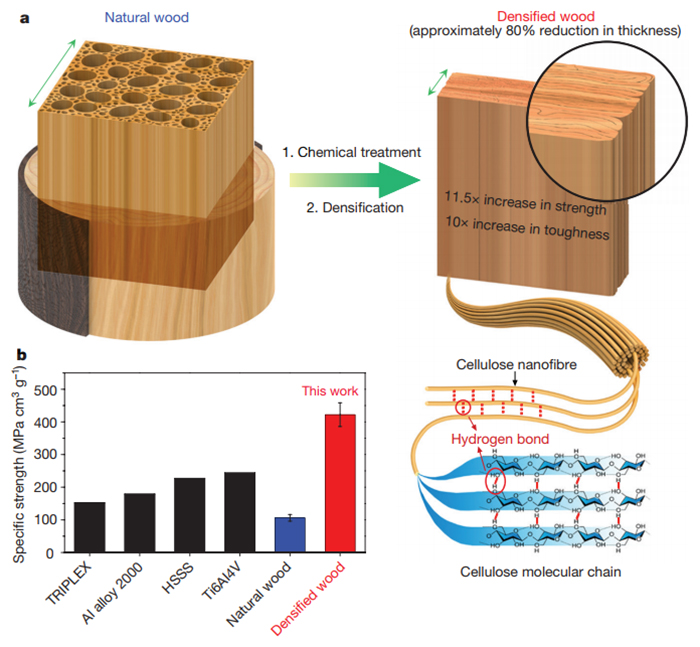If only there was a way we could get more trees... maybe if we put something in the ground and leave it for a bunch of years? idk, need to get scientists on this, stat.Really think about what you posted. How are trees a finite resource?
-
Ever wanted an RSS feed of all your favorite gaming news sites? Go check out our new Gaming Headlines feed! Read more about it here.
-
We have made minor adjustments to how the search bar works on ResetEra. You can read about the changes here.
Scientists Have Developed a Way to Make Wood as Strong as Steel
- Thread starter Ether_Snake
- Start date
You are using an out of date browser. It may not display this or other websites correctly.
You should upgrade or use an alternative browser.
You should upgrade or use an alternative browser.
yes, all the wood mines are running outUh, wood is a finite resource isn't it? Does that really solve any future resource issue?
It's not like it grows on trees. Uh wait. Wut?Uh, wood is a finite resource isn't it? Does that really solve any future resource issue?
Asking for a friend
Yes there obviously isn't an issue with deforestation... Hurrdurr
I seem to recall reading some futurist speculation (no doubt extrapolated from sci-fi authors) of these "super wood" materials eventually being used in he construction of modern spacecraft. I find it pretty fascinating to think on, though I don't doubt that once large-scale asteroid mining is cost-effective, moving back to modern metals would be the better option.
Depends, in theory wood itself could be grown in a lab without growing actual trees. Now that would imply some serious genetic engineering, but "lab-grown" could potentially be the source of most material in the future.
I mean, you can grow trees just like any other crop. Obviously you don't want to just decimate current forests but trees aren't exactly finite.Uh, wood is a finite resource isn't it? Does that really solve any future resource issue?
If it was that easy we wouldn't have deforestation issues without even using this method.
SOLD!
Deforestation is an issue, but that doesn't mean wood is finiteIf it was that easy we wouldn't have deforestation issues without even using this method.
If it was that easy we wouldn't have deforestation issues without even using this method.
Deforestation has nothing to do with using wood, it has to do with removing forest to use the land for farming.
Deforestation is an issue, but that doesn't mean wood is finite
Replacing steel with wood certainly doesn't make that statement undoubtable, considering how widespread the use of steel is.
Ummm, you really haven't thought this through have you.Yes there obviously isn't an issue with deforestation... Hurrdurr
Would be neat if we have new structural materials. Carbon fiber is nice and all but it's not appropriate I'm one type of applications and have several weaknesses. They are also expensive and harder to recycle.
We still the metals as conducting materials so we still need to conserve them.
We still the metals as conducting materials so we still need to conserve them.
And people laughed at the original pitch for Alien 3.50 years from now we'll be conquering the galaxy on wooden ships!
I don't understand why people are giving ISOM such a hard time. Over any reasonable given time period, you will have a limited quantity of wood for actual use bound by its production factors. That's just looking at the supply side. How much wood would be required to produce the same amount of structures or goods as present day metallic alloys for it to be a suitable substitute? How much energy is consumed in the densification process (probably less than smelting but still something to consider)? Will companies and regulations all over the world carefully manage their forests and replanting efforts or will they exploit and aim for harmful high production methods without being mindful of long term impacts? While animal agriculture is the largest cause of deforestation, wood products are still identified as one of the four biggest drivers, accounting for ~10%. While this is certainly an exciting development, I don't think concerns surrounding its environmental impact can be dismissed so easily.
Super wood performances in wet environments the best
I wonder if these folks got the idea after watching Antman
They pointed out you can shrink balsa and pine down to make material comparable to old growth wood. So it might actually be beneficial in that regard.Uh, wood is a finite resource isn't it? Does that really solve any future resource issue?
Not enough science up in this thread:

EDIT: There's a bit of detail in the article, the vaguest points being around the sorts of temperatures and pressures needed to produce the required effects. My guess would be that it'll be much easier to produce smaller pieces, due to the size of industrial presses, and the inability to weld pieces together mean wooden skyscrapers aren't as likely as a new generation of wooden houses. Wooden car panels are a thought due to the ability to shape the wood as part of the process, as well as just improving stuff we currently use wood for, like doors and flooring, or replacing steel in situations where it's expensive but overkill, like handrails and sign posts.
My main thought is how the material will react when drilled, and will a simple bolt hold it in place or will something like that cause it to fracture under load. That sort of thing. There's a lot of potential, but it isn't clear how everyday the use of 'super wood' could be, or will it be the preserve of those manufacturing products on assembly lines due to it being a pain to work with after treatment.

EDIT: There's a bit of detail in the article, the vaguest points being around the sorts of temperatures and pressures needed to produce the required effects. My guess would be that it'll be much easier to produce smaller pieces, due to the size of industrial presses, and the inability to weld pieces together mean wooden skyscrapers aren't as likely as a new generation of wooden houses. Wooden car panels are a thought due to the ability to shape the wood as part of the process, as well as just improving stuff we currently use wood for, like doors and flooring, or replacing steel in situations where it's expensive but overkill, like handrails and sign posts.
My main thought is how the material will react when drilled, and will a simple bolt hold it in place or will something like that cause it to fracture under load. That sort of thing. There's a lot of potential, but it isn't clear how everyday the use of 'super wood' could be, or will it be the preserve of those manufacturing products on assembly lines due to it being a pain to work with after treatment.
Last edited:
Not enough science up in this thread:

EDIT: There's a bit of detail in the article, the vaguest points being around the sorts of temperatures and pressures needed to produce the required effects. My guess would be that it'll be much easier to produce smaller pieces, due to the size of industrial presses, and the inability to weld pieces together mean wooden skyscrapers aren't as likely as a new generation of wooden houses. Wooden car panels are a thought due to the ability to shape the wood as part of the process, as well as just improving stuff we currently use wood for, like doors and flooring, or replacing steel in situations where it's expensive but overkill, like handrails and sign posts.
My main thought is how the material will react when drilled, and will a simple bolt hold it in place or will something like that cause it to fracture under load. That sort of thing. There's a lot of potential, but it isn't clear how everyday the use of 'super wood' could be, or will it be the preserve of those manufacturing products on assembly lines due to it being a pain to work with after treatment.
Just glue pieces together.
Put as much wood as you can into as little space as you can.
The wood is now denser.
Grants, pls.
Put as much wood as you can into as little space as you can.
The wood is now denser.
Grants, pls.
eh, I'm talking about gluing as binding technique for super wood parts. Modern industry adhesives are so stupid strong that those aren't weak links like welding joints but unlike welding you don't fuck up with the surrounding atomic structure.
eh, I'm talking about gluing as binding technique for super wood parts. Modern industry adhesives are so stupid strong that those aren't weak links like welding joints but unlike welding you don't fuck up with the surrounding atomic structure.
What about gluing a bunch of GameCubes together to increase processing power
That'd work for some uses, sure. I'm thinking about heavier duty long-term use, that might be regularly exposed to the elements or vibration forces or whatever, that would make glues unsuitable.
Reminds me of pykrete (a frozen composite of wood pulp and water) which has a comparable tensile strength to concrete. This is obviously more practical though.
Next steps?
-growing the subject wood within a mould
-finding a way to artificially accelerate wood growth
-applying this densification process to the moulded wood
grow entire single-body structures. Could this be good for space frames and the like?
-growing the subject wood within a mould
-finding a way to artificially accelerate wood growth
-applying this densification process to the moulded wood
grow entire single-body structures. Could this be good for space frames and the like?
Uh, wood is a finite resource isn't it? Does that really solve any future resource issue?
How the heck is wood finite. You just plant more no?






